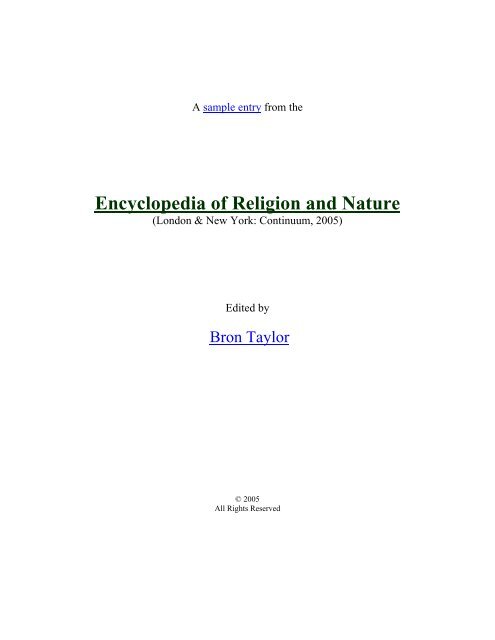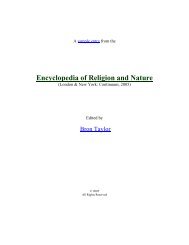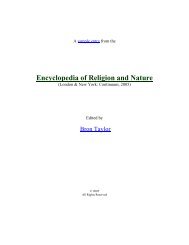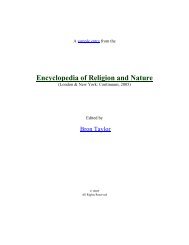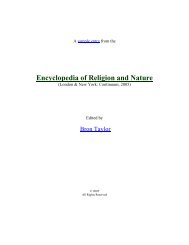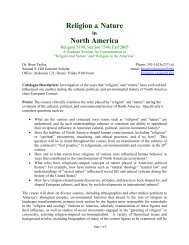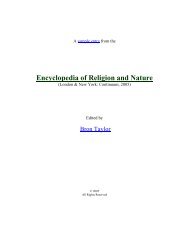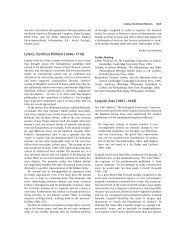Rock Climbing - Religion and Nature
Rock Climbing - Religion and Nature
Rock Climbing - Religion and Nature
You also want an ePaper? Increase the reach of your titles
YUMPU automatically turns print PDFs into web optimized ePapers that Google loves.
A sample entry from the<br />
Encyclopedia of <strong>Religion</strong> <strong>and</strong> <strong>Nature</strong><br />
(London & New York: Continuum, 2005)<br />
Edited by<br />
Bron Taylor<br />
© 2005<br />
All Rights Reserved
1398 <strong>Rock</strong> <strong>Climbing</strong><br />
nest in an earthly way. It can also fly up into the sky where<br />
the cloud-beings live, its power of flight so easy, so natural.<br />
And, most magically of all, not only can it swim <strong>and</strong><br />
float on water, it can also dive under the water – <strong>and</strong> come<br />
back up again! To a people who likely saw puddles <strong>and</strong><br />
ponds as an entryway to the underworld, this must have<br />
seemed the epitome of magic.<br />
Other water birds such as cranes or coots or herons (or<br />
their footprints) are also widely represented in the prehistoric<br />
rock art of the desert southwest, not surprising in<br />
cultures that were trying to eke out an existence in places<br />
where the rainfall was often far below the prerequisite 14<br />
inches a year that are considered minimum for human<br />
survival. With the idea of supplication for rain, it is no<br />
wonder that water birds images are so prevalent, as are<br />
those of clouds, frogs, tadpoles, <strong>and</strong> fish. Images of turkeys<br />
were often associated with rain also, as these birds tended<br />
to reside in the mountains where there was more water,<br />
next to springs <strong>and</strong> streams, just as they do today.<br />
It is a logical extension of bird imagery that bird feathers<br />
<strong>and</strong> bird parts served as a metaphor for the whole<br />
bird, <strong>and</strong> there is a long tradition brought forward into the<br />
present of using bird feathers in connection with sacred<br />
ceremonies, altars, prayer bundles, dances <strong>and</strong> rituals, <strong>and</strong><br />
shamanic costumes. “Of all life forms found as decorative<br />
motifs in Pueblo art, the bird has undoubtedly enjoyed the<br />
most widespread use. Bird designs occur abundantly on<br />
prehistoric <strong>and</strong> historic culture materials from the Pueblo<br />
region” (Wellman 1976: 97).<br />
Bird imagery in the Rio Gr<strong>and</strong>e style rock art is quite<br />
often generic (depending on the site); that is, the idea of<br />
birds is presented, though no effort has been made to suggest<br />
a specific kind of bird. And just as often, a specific<br />
bird image may dominate a site, such as raptors in Tenabo,<br />
New Mexico, the duck-men of the San Juan River area<br />
in southeastern Utah, the star-faced birds of prey in the<br />
Galisteo Basin in north central New Mexico, or the<br />
owl-men of Dinwoody Lakes, Wyoming.<br />
And there are some sites that are wonderfully <strong>and</strong><br />
inexplicably anomalous, such as the premier rock-art site<br />
of Three Rivers, in southern New Mexico. This remarkable<br />
site, with its many thous<strong>and</strong>s of petroglyphs pecked into<br />
the basaltic lava along a hogback rising above the desert<br />
floor, hosts at least fourteen separate, identifiable species<br />
of birds, as well as birds with eggs in their bodies, bird<br />
migrations, seasonal portrayals <strong>and</strong> even a bird embryo,<br />
where the oval shape of the rock forms the egg. Most of the<br />
images are portrayed alone, <strong>and</strong> a few seem to have an<br />
overt shamanic context, though certainly the wide variety<br />
of images has generated numerous, often conflicting<br />
interpretations.<br />
Unraveling the mystery of the many different bird species<br />
represented at Three Rivers is an appropriate metaphor<br />
for the study of the larger world of rock art. Not only<br />
by learning to live with the mystery without having to<br />
explain it rationally on our own terms, but also by accepting<br />
it as the essence of the magic inherent in rock art, <strong>and</strong><br />
learning, each in our own way, how to celebrate (<strong>and</strong> protect)<br />
that mystery, may we come into a true contact with<br />
the many people who left them there so long ago.<br />
Brad Draper<br />
Further Reading<br />
Hedges, Ken. “Southern California <strong>Rock</strong> Art as Shamanic<br />
Art.” In American Indian <strong>Rock</strong> Art, vol. 2. El Paso, TX:<br />
El Paso Archeological Society, 1976.<br />
Schaafsma, Polly. “Trance <strong>and</strong> Transformation in the<br />
Canyons: Shamanism <strong>and</strong> Early <strong>Rock</strong> Art of the Colorado<br />
Plateau.” In Shamanism <strong>and</strong> <strong>Rock</strong> Art in North<br />
America. San Antonio, TX: <strong>Rock</strong> Art Foundation, Inc.,<br />
1994.<br />
Schaafsma, Polly. “Supper or Symbol: Roadrunner Tracks<br />
in Southwest Art <strong>and</strong> Ritual.” In Animals into Art.<br />
Howard Morphy, ed. London: Unwin Hyman, 1989.<br />
Turpin, Solveig. “On a Wing <strong>and</strong> a Prayer: Flight Metaphors<br />
in Pecos River Art.” In Shamanism <strong>and</strong> <strong>Rock</strong> Art<br />
in North America. San Antonio, TX: <strong>Rock</strong> Art Foundation,<br />
Inc., 1994.<br />
Wellman, Klaus F. “Some Observations on the Bird Motif<br />
in North American Indian <strong>Rock</strong> Art.” In American<br />
Indian <strong>Rock</strong> Art, vol. 2. El Paso, TX: El Paso Archeological<br />
Society, 1976.<br />
Whitley, David. “Shamanism, Natural Modeling <strong>and</strong> the<br />
<strong>Rock</strong> Art of the Western North American Hunter-<br />
Gatherers.” In Shamanism <strong>and</strong> <strong>Rock</strong> Art in North<br />
America. San Antonio, TX: <strong>Rock</strong> Art Foundation, Inc.,<br />
1994.<br />
See also: Paleolythic <strong>Religion</strong>s; <strong>Rock</strong> Art (various);<br />
Shamanism (various).<br />
P<br />
<strong>Rock</strong> <strong>Climbing</strong><br />
Can rock climbing be understood as a religion? As a practitioner<br />
<strong>and</strong> a scholar, I think it can. Surely it entails a<br />
sensation of transcendence, an experience of raw nature,<br />
<strong>and</strong> calls forth a kind of reverence. <strong>Climbing</strong> offers a<br />
respite from the constraints of the horizontal world, recreating<br />
the axis mundi with each new ascent. While such<br />
sentiments convey aspects of what I feel when I climb,<br />
they serve only to obscure what I see as a scholar. As much<br />
as I’m prone to romanticizing my choice of leisure pursuits,<br />
here I want to approach climbing with a critical eye,<br />
still under the broad category of religion. This entails a<br />
shift to ritual. If we view climbing as ritualized behavior,<br />
we move beyond platitudes <strong>and</strong> speculations about the<br />
“beliefs” of climbers to analyze the social processes <strong>and</strong><br />
practices they perform.<br />
<strong>Climbing</strong> is almost wholly ritualized. This will become<br />
readily apparent to anyone who attempts to invent the<br />
sport de novo, as I did in my hapless early teenage years.
<strong>Rock</strong> <strong>Climbing</strong> 1399<br />
Armed with a bike lock, leather gloves, <strong>and</strong> an old sailing<br />
line, my friend Dan <strong>and</strong> I decided to “go climbing.” Before<br />
we had much of an opportunity to kill ourselves, Dan <strong>and</strong> I<br />
were approached by some “real climbers” who, while<br />
chuckling the we-know-better laugh, took us under their<br />
wing <strong>and</strong> initiated us into the esoterica at the heart of the<br />
sport. In language <strong>and</strong> gestures meant to close the gap<br />
between our ignorance <strong>and</strong> their “reality,” we were taught<br />
about the acquisition <strong>and</strong> use of proper ritual paraphernalia<br />
(ropes, carabineers, <strong>and</strong> anchors), appropriate regalia<br />
(climbing boots, designer clothes), ritual speech (“on<br />
belay”), sacred texts (guide books <strong>and</strong> various “how to”<br />
texts written by “founding fathers”), ongoing revelation<br />
(climbing magazines), sacrificial rituals (leisure blood letting<br />
by way of cuts <strong>and</strong> bruises – “badges of honor” – <strong>and</strong><br />
the occasional involuntary corpse offering), salient ethnic<br />
distinctions (sport climbers, traditional climbers, alpine<br />
climbers), relevant ancestors <strong>and</strong> deities (local heroes),<br />
heretics (heroes from somewhere else), <strong>and</strong> most importantly,<br />
levels of salvation (grades of difficulty) <strong>and</strong> ethics<br />
(aesthetics – “good style”). More than this, we learned that<br />
“real climbing” is established around certain pilgrimage<br />
sites (Yosemite being Mecca <strong>and</strong> Jerusalem both), <strong>and</strong> only<br />
the apostate (independently minded climbers) or the<br />
visionary (sponsored climbers) venture beyond the sanctioned<br />
<strong>and</strong> sanctified cathedrals. However, meeting the<br />
needs of practitioners who can’t always <strong>and</strong> everywhere<br />
engage “pure tradition” (going climbing), climbers have<br />
invented traditions to match their late capitalist predilections<br />
(climbing gyms with espresso bars <strong>and</strong> interactive<br />
websites that successfully reproduce the social milieu –<br />
which is garden-variety, pecking-order calibration – of the<br />
“really real”).<br />
Now, lest my critical view be taken as cynicism, let me<br />
point out the positive attributes of climbing as ritual.<br />
There is more communitas in climbing circles than there<br />
are bad dissertations on liminality – which is to say heaps.<br />
<strong>Climbing</strong> is about bonding, <strong>and</strong> bonding quite beyond the<br />
structures <strong>and</strong> constraints of everyday life. If there was<br />
ever “serious play,” this is it. At the level of rope mate,<br />
trust is paramount <strong>and</strong> all ascents are dually authored <strong>and</strong><br />
doubly experienced. Beyond the sacred duty to one’s partner<br />
(holding his or her rope), climbing bonds extend like<br />
fractals, taking in ever-greater numbers of people yet linking<br />
them in the most intimate ways. Moreover, the very<br />
ritualism of climbing is so explicit <strong>and</strong> marked that it constitutes<br />
the primary identity of most adherents. This makes<br />
climbers remarkably visible <strong>and</strong> sympathetic to one<br />
another (intra-ethnic strife aside). Thus, to speak personally,<br />
I am certain that I have more in common – in terms of<br />
passions, appetites, ideals – with climbers from, say, Thail<strong>and</strong>,<br />
than I do with my neighbors. So it is that climbers<br />
can travel the world <strong>and</strong> have ready-made communities<br />
waiting to accept them. So, while climbers fashion themselves<br />
as radicals, independents, <strong>and</strong> iconoclasts, what I<br />
find revealing in our ritual analysis is that it is precisely<br />
the sub-cultural homogeneity of climbing – produced <strong>and</strong><br />
reproduced through ritual practices – that renders climbing<br />
the social phenomenon it is.<br />
Turning to the sharper edge of my critical knife, I want<br />
to address the relationship of climbers to nature by way of<br />
exposing one particular class of rituals to analysis: the<br />
first ascent. Climbers most often take the first ascent to be<br />
the epitome of the sport. It represents the “best <strong>and</strong> purest”<br />
form of climbing. Adventurous, bold, committed, visionary,<br />
self-less: these are common ways first ascentionists<br />
fashion themselves, <strong>and</strong> most climbers endorse this discourse<br />
through consumption of it. As a first ascentionist<br />
myself, I’ve participated in this rhetorical economy, <strong>and</strong> I<br />
think many of the claims <strong>and</strong> aspirations surrounding first<br />
ascents are sincere <strong>and</strong> harmless. However, I would insist<br />
that the quest for the perfect route (climbing’s Holy Grail)<br />
by climbers as a whole <strong>and</strong> the quest for ego gratification<br />
by individuals have caused climbing to manifest itself in<br />
rather imperial ways. New climbing areas are sought with<br />
the fervor of New World explorers, <strong>and</strong> the consequences<br />
to nature (<strong>and</strong> sometimes natives, as with disputes<br />
between climbers <strong>and</strong> Indians at Devils Tower <strong>and</strong> Cave<br />
<strong>Rock</strong> attest) are similar in effect, but certainly not in scale,<br />
to those of their symbolic predecessors. Trails are cut,<br />
vegetation is removed, machinery bolts are drilled into the<br />
rock for anchors, erosion exacerbated, <strong>and</strong> litter is left by<br />
climbers “developing” new climbs.<br />
I would also call attention to symbolic features of first<br />
ascents that strike me as dubious <strong>and</strong> revealing. These are<br />
signaled by the metaphor often chosen by climbers to<br />
describe establishing a first ascent: authorship. Climbers<br />
speak as if the act of climbing a rock somehow brings it<br />
into being – <strong>and</strong> so it does, for a certain social world.<br />
Beyond this, authorship is viewed to convey moral possession<br />
of the route to those who established it. In other<br />
words, subsequent climbers are to repeat the route by way<br />
of the st<strong>and</strong>ards of the first ascentionists, <strong>and</strong> any modification<br />
of the route (the addition of new anchors, for<br />
example) requires consent from its “authors.” Moreover,<br />
first ascentionists very often underst<strong>and</strong> their act as one<br />
that confers entitlement in another sense. Quite literally,<br />
climbers have a long tradition of claiming the right to<br />
naming based on the first ascent. Even if a rock feature<br />
had a name before an ascent, climbers will re-christen the<br />
rock upon climbing it. And, in ways reminiscent of the<br />
Reformation, climbers will, on occasion, dispute the legitimacy<br />
of an ascent, registering their view by climbing it<br />
themselves <strong>and</strong> renaming it upon success. Route names<br />
enter climbing discourse swiftly <strong>and</strong> indelibly, eventually<br />
becoming recorded in guidebooks, often along with the<br />
“author’s” name. In this way, first ascents are perhaps best<br />
viewed in terms of apotheosis – human beings reaching<br />
for the gods in order to become them. As with so many<br />
human projects to transcend our limitations, in the game
1400 Rolston III, Holmes<br />
of climbing nature often becomes a means to our ends –<br />
even while we purport to be worshipping it.<br />
Yet, if we grant certain ego needs <strong>and</strong> failures to our<br />
kind, perhaps we can view climbing – <strong>and</strong> things like it –<br />
as simultaneously muddled <strong>and</strong> miraculous. On the latter<br />
side, climbing, for all of my skepticism, still affords the<br />
chance to gain a celestial view from a terrestrial perch.<br />
Doing so, climbing allows for an oceanic experience that<br />
inspires a caring rather than a conquering attitude toward<br />
the rock. And it must be said that within the climbing<br />
community there has always been a vocal environmentalist<br />
element. These climbers – from the very beginning of<br />
the sport – have maintained a “clean” ethic, seeking to<br />
leave no trace on the rocks they ascend. Moreover, their<br />
sensibilities extend to the broader context of public l<strong>and</strong><br />
use. Such climbers <strong>and</strong> the action groups they form <strong>and</strong><br />
support have been instrumental in advancing low-impact<br />
approaches to nature.<br />
Greg Johnson<br />
See also: Deep Ecology; Mountaineering; Naess, Arne;<br />
Surfing.<br />
Rolston III, Holmes (1932–)<br />
Leading environmental philosopher, ethicist, <strong>and</strong> theologian,<br />
Holmes Rolston III is widely recognized as the<br />
“father of environmental ethics” for his central role in<br />
developing environmental ethics as a modern academic<br />
discipline. Throughout his distinguished career, he has<br />
helped make explicit the ethics of nature that have been<br />
implicit in philosophical <strong>and</strong> sacred writings since ancient<br />
times. Born in the Shen<strong>and</strong>oah Valley of Virginia on 19<br />
November 1932, Rolston’s multidisciplinary educational<br />
career included a childhood spent in contact with nature,<br />
an undergraduate degree in physics (Davidson College,<br />
1953), a divinity degree (Union Theological Seminary,<br />
1956), a Ph.D. in theology (University of Edinburgh,<br />
1958), <strong>and</strong> later a masters in philosophy of science (University<br />
of Pittsburgh, 1968). He wrote the acclaimed books<br />
Philosophy Gone Wild (1986), Environmental Ethics<br />
(1988), Science <strong>and</strong> <strong>Religion</strong>: A Critical Survey (1987),<br />
Conserving Natural Value (1994), <strong>and</strong> Genes, Genesis <strong>and</strong><br />
God: Values <strong>and</strong> their Origins in Natural <strong>and</strong> Human History<br />
(Gifford Lectures, University of Edinburgh, 1997–<br />
1998) (1999). He edited Biology, Ethics, <strong>and</strong> the Origins of<br />
Life (1994), <strong>and</strong> in 1979, helped found the now-refereed<br />
professional journal Environmental Ethics. Additional<br />
works include 80 chapters in other books <strong>and</strong> over 100<br />
articles, a number of which have been used in college<br />
courses <strong>and</strong> have been translated into at least a dozen<br />
languages. A founding member of the International Society<br />
for Environmental Ethics (1990) <strong>and</strong> delegate to the<br />
United Nations Conference on Environment <strong>and</strong> Development<br />
(Rio de Janeiro, Brazil, 1992), Rolston has lectured<br />
on all seven continents, consulted with dozens of conservation<br />
groups, received numerous awards including the<br />
2003 Templeton Prize for Progress Toward Research or<br />
Discoveries about Spiritual Realities, <strong>and</strong> currently serves<br />
as University Distinguished Professor of Philosophy at<br />
Colorado State University, his professorial post since<br />
1976.<br />
For four centuries following the Enlightenment <strong>and</strong><br />
the scientific revolution in Europe, Western philosophy<br />
promoted an almost exclusively anthropocentric focus,<br />
perceiving nature as mechanistic <strong>and</strong> only having value<br />
in relation to human uses <strong>and</strong> preferences. In the early<br />
1970s, Rolston acknowledged that nature had instrumental<br />
or use-values for medicine, agriculture, <strong>and</strong><br />
industry. He went further, though, recognizing that<br />
nature had other values – aesthetic, ecological, educational,<br />
historical, recreational, scientific, economic, <strong>and</strong><br />
religious – as well as intrinsic value. Fundamentally, he<br />
argued, organisms (including plants, animals, <strong>and</strong><br />
humans), species, ecosystems, <strong>and</strong> the Earth have<br />
intrinsic value just for the fact that they have evolved<br />
<strong>and</strong> survived for millions <strong>and</strong> billions of years. Each level<br />
also has systemic value (value associated with processes<br />
<strong>and</strong> capacity to produce) that is interwoven with instrumental<br />
<strong>and</strong> intrinsic values. Rolston posits that for all of<br />
these reasons <strong>and</strong> more, humans have ethical obligations<br />
to the environment.<br />
An ordained Presbyterian pastor like his father <strong>and</strong><br />
gr<strong>and</strong>father, Rolston frequently draws on the Bible,<br />
emphasizing in writing <strong>and</strong> in lectures its implied guidance<br />
on environmental ethics. He likes to think of the<br />
“swarms of living creatures” brought forth from l<strong>and</strong> <strong>and</strong><br />
sea (Gen. 1:20, 24) as early references to biodiversity <strong>and</strong><br />
notes that when God reviewed the display of life he found<br />
it “very good.” According to Rolston, the story of Noah’s<br />
ark illustrates that God wills for species to continue (Gen.<br />
6:19) <strong>and</strong> the rainbow is God’s sign re-establishing “the<br />
covenant . . . between me <strong>and</strong> you <strong>and</strong> every living creature<br />
that is with you, for all future generations” (Gen.<br />
9:12–13). In addition to the ecological, intrinsic, aesthetic,<br />
instrumental, <strong>and</strong> religious values implied in Genesis <strong>and</strong><br />
Matthew 6, Rolston highlights biblical passages that speak<br />
to economic <strong>and</strong> other values, as well as human<br />
responsibilities.<br />
Rolston promotes the idea that ethics are for people, but<br />
not only about people. To whom much is given, much is<br />
required, <strong>and</strong> humans have a rich <strong>and</strong> ancient inheritance,<br />
the Earth <strong>and</strong> biosphere, to steward. Rolston says that perhaps<br />
we make our deepest error “forever putting ourselves<br />
first, never putting ourselves in place in the fundamental<br />
biosphere community in which we reside” (2000: 83).<br />
Through his writings <strong>and</strong> lectures, he attempts to instill<br />
a more profound sense of civic <strong>and</strong> environmental


